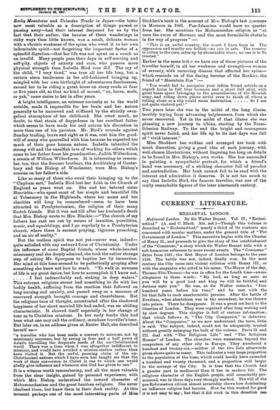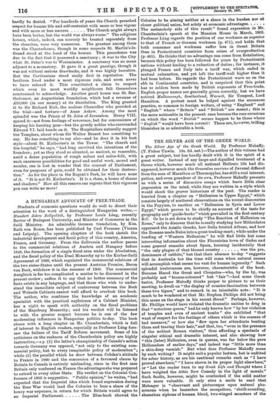CURRENT LITERATU RE.
MEDIAEVAL LONDON.
Mediaeval London. By Sir Walter Besant. Vol. II., "Eoelesi- astiold.- (A. and C. Black. 30s. net.)—Though this volume is described as "Ecclesiastical," nearly a third of its contents are concerned with secular matters, under the general title of "The Government of London." This narrative begins with the Charter of Henry IL, and proceeds to give the story of the establishment of the "Commune," a story which Sir Walter Besant tells with a sub-humorous referenoe to more recent events. The " Commune" dates from 1191; the first Mayor of London belongs to the year 1193. The battle was not, indeed, finally won. In the next century the City came into violent collision with Henry III., or with the magnates who acted in his name. The Mayor of the day, Thomas Pits-Thomas—he was in office for the fourth time--swore allegiance in these words "My lord, as long as unto us you will be a good lord and king we will be faithful and dutious unto you." He was, as Sir Walter remarks, "four hundred years before his time," and he met with the lot that falls to such anachronistic persons. After the battle of Evesham, when absolutism was in the ascendant, he was thrown into prison. There he disappears. It was a great set-back to the liberties of London. They were regained after long waiting and by slow degrees. This chapter is full of curious information ; that which follows it, "The City Companies," is defective. About the "Companies," as we now understand the term, little is said. The subject, indeed, could not be adequately treated without greatly enlarging the bulk of the-volume. Parts II. and III. deal with "The Religious Life" and "The Religious Houses" of London. The churches were numerous, beyond the comparison of any other city in Europe. They numbered a hundred and twenty-six,—neither of the two lists afterwards given shows quite as many. This indicates a very large proportion to the population of the time, which could hardly have exceeded a hundred and twenty thousand, and a proportion still larger to the acreage of the City. It is true that the Church had a greater part in mediaeval than it has in modern life. The religious character of the English people, still remarkably pro- nounced, was in those days very strongly marked. The will of the pre-Reformation citizen almost invariably shows how dominating an influence religion had become. How far this worked for good it is not easy t,o my; but that it did work in this direction can
hardly be denied. "For hundreds of years the Church preached respect for human life and self-restraint with more or less vigour
and with more or less success The Church might always have been better, but the world was always worse." The religious houses, which, indeed, can scarcely be treated, separately from the churches, were very numerous. The greatest among them was the Charterhouse, though in some respects St. Martin's-le- Grand stood at the bead of the houses. This precedence was due to the fact that it possessed a sanctuary ; it was to the City what St. Peter's was to Westminster. A sanctuary was no mean adjunct to a monastery. It gave it a great prestige, though it was not without serious drawbacks, and it was highly lucrative. But the Carthusians stood easily first in reputation. The brethren lived under a most rigorous rule, and seem never to have relaxed it. This constituted a claim to respect which even its most worldly neighbours felt themselves constrained to acknowledge. Another great house was St. Bar- tholomew, an Augustinian foundation, which had a revenue of -£10,000 (in our money) at its dissolution. The King granted it to Sir Richard Rich, the zealous Chancellor who presided at the trial—and torture—of Anne Askew. Among the most splendid was the Priory of St. John of Jerusalem. Henry VIII. spared it—not from feelings of reverence, but for convenience of keeping his hunting gear—but the greedy nobles who surrounded Edward VI. laid hands on it. The Hospitallers naturally suggest the Templars, about whom Sir Walter Besant has something to say. He has something to say also—and he does it in his best style—about Si, Katherine's in the Tower. "The church and the hospital," he says, "had long survived the intentions of the founders ; yet as they stood so situated, so ancient, so venerable, amid a dense population of rough sailors and sailor-folk, with such enormous possibilities for good and useful work, sacred and secular, one is lost in wonder that the consent of Parliament, even for purposes of gain, could be obtained for their destruc- tion." As for the place in the Regent's Park, he will have none of it. "Ii is not St. Katherine's. It is a sham, a house of shams and shadows." How all this renews our regrets that this vigorous pen can write no more !























































 Previous page
Previous page